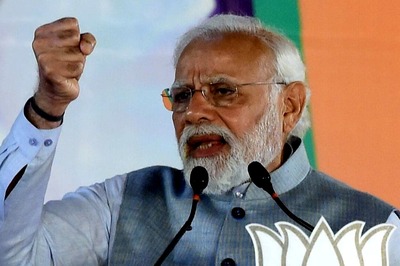
views
The two schemes, PM-Kisan and Ayushman Bharat, that aim to benefit millions of the underprivileged on two most important needs of life – financial and health assistance – have seen bitter war of words between Prime Minister Narendra Modi and West Bengal Chief Minister Mamata Banerjee.
Mamata calls them Modi promotional schemes and says the schemes launched by her are better suited to help people in need.
PM-Kisan vs Krishak Bandhu
West Bengal is the only state government that has not implemented the scheme so far. Prime Minister Narendra Modi launched the scheme on February 24, 2019. The scheme provides financial assistance of Rs 6,000 in three installments to a farmer’s family. The scheme was initially aimed at small and marginal farmers but was extended to all farmers in June 2019.
Mamata initially did not accept the direct benefit transfer mode in a state that is primarily agrarian with 7.13 million farmer families and 96% of these are small and marginal farmers against the national average of 86.2%. She wanted her government to be an intermediary in a scheme where the central government bears the 100% responsibility on benefit transfer. But in January, she finally hinted to run the scheme in its original format.
The policy adopted here, of direct benefit transfer, has been hailed by experts and analysts and in fact is doing very well even in the Opposition-ruled states like Maharashtra and Punjab. Maharashtra is among the top 5 performing states in implementing the PM-Kisan benefit transfer. The direct benefit transfer mode eliminates the need of middlemen or any officer or even a political leader.
But Mamata’ stand here has largely deprived farmers of this much needed assistance. According to a report in the Economic Times, 2.26 million farmers of the state self-registered themselves on the PM-Kisan portal by December 2020 but they could not get any benefit as they were not verified by the West Bengal state government.
What farmers have missed so far is Rs 14,000 to each farmer, or Rs 9,800 crore across the state.
Mamata’s counterpoint: Mamata said last month that after the Central Government sent a list of six lakh applicants, the state government did send back a list of 2.5 lakh eligible names, yet no money has been disbursed so far.
She also highlights the Krishak Bandhu Scheme of the West Bengal state government. Mamata increased the annual cash assistance to farmers to Rs 6,000 from earlier Rs 5,000 in this year’s state budget. Mamata announced this financial scheme in December 2018 which claims to cover all farmers of the state.
But the point to consider here is, Mamata, may have diverted the additional assistance that West Bengal farmers might have got, in addition to the state government assistance.
Pradhan Mantri Jan Arogya Yojana (Ayushman Bharat) Vs Swashtya Sathi
A participating state has to bear 40% premium liability per beneficiary family unlike PM-Kisan where the Central Government bears the 100% responsibility. The scheme aims at helping about 50 crore people, or 10.74 crore poor families, by providing an annual health cover of Rs 5 lakh per family.
Mamata initially refused to implement the scheme saying she will only give the scheme a go-ahead if the funds required were routed through the state government. She later agreed after it was decided that Ayushman Bharat and West Bengal’s health assistance scheme Swasthya Sathi would be merged and run under the name of the state government scheme, but only to disagree later, saying it was just a Modi promotional scheme with health cards carrying Modi’s photo. Mamata had launched the Swasthya Sathi scheme in February 2016.
Mamata’s counterpoint: Till December 2020, the state government had registered 1.4 crore under-privileged beneficiaries but now has extended it to all citizens of the state. Mamata says Ayushman Bharat intended to cover 1.5 crore people but her government is now covering 10 crore people or everyone without health insurance and has empaneled private hospitals along with government hospitals.
The state government adds that the state government scheme that gives basic health cover of Rs 5 lakh per annum per family, is better than the Central Government’s scheme. Unlike Ayushman Bharat, Swashtya Sathi covers the beneficiary as well as the extended family. Unlike Ayushman Bharat, that is limited to a section of people, Swasthya Sathi scheme covers every one.
What is on ground: Jaideep Mazumdar, Associate editor at Swarajya Magazine, says most of the private hospitals in West Bengal are refusing to treat the Swasthya Sathi card patients due to the low rates that come with the scheme. They find the rates highly unviable. Private hospitals empaneled with Aysuhman Bharat don’t face this problem.
Also, with the scheme now covering the entire state population, even the government hospitals are now finding it difficult to treat Swashtya Sathi card patients seeing the rush.
Mazumdar adds that another problem that a patient with a Swasthya Sathi card may face in West Bengal is the chance of getting the required treatment in a hospital that is outside of the state. While a patient with Ayushman Bharat card can visit any hospital in India for his treatment, a Swasthya Sathi card patient doesn’t have this option.
Also, according to the latest Economic Survey, Ayushman Bharat led to better health insurance coverage in the neighboring states of West Bengal, in Assam, Bihar and Sikkim, where coverage increased by 89% while it dipped by 12% in West Bengal. Infant mortality rate declined by 28% in neighboring states, while by 20% in West Bengal. Neighboring states saw contraception going up by 36% and female sterilisation up by 22% while West Bengal saw almost negligible changes on these important health indicators.
Read all the Latest News, Breaking News and Coronavirus News here


















Comments
0 comment